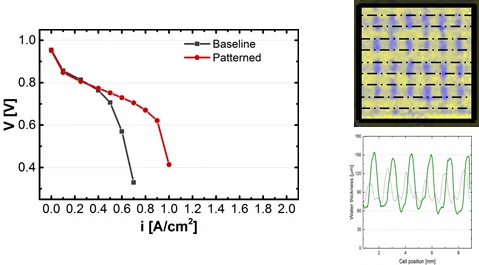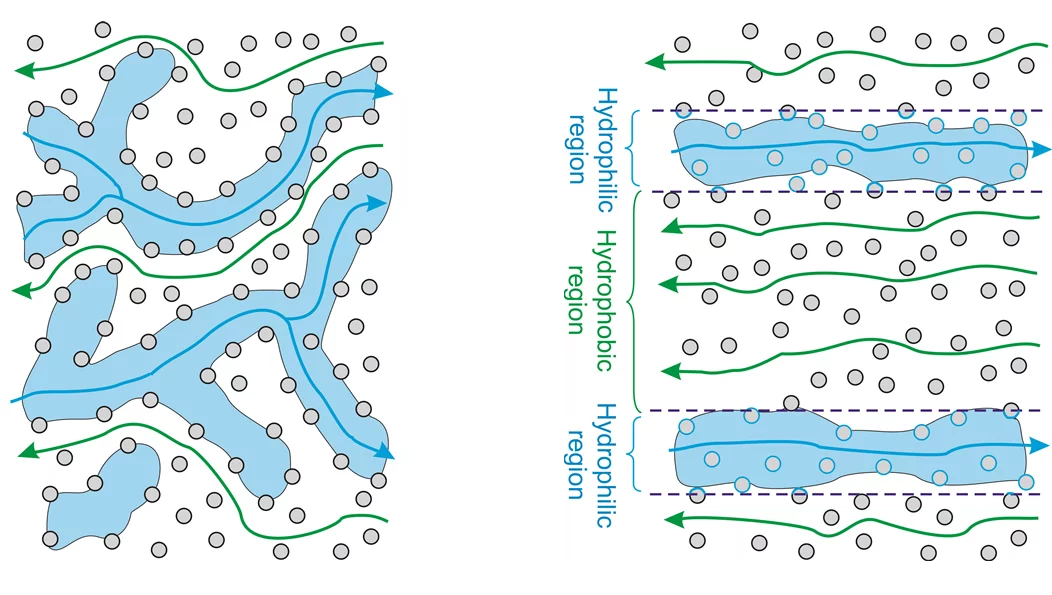During PEFC’s operation the reactant gas is fed to the cell through the gas diffusion layer (GDL) and through the same material the product water is removed. Water accumulation near the catalyst can block the gas access causing an increase of the mass transport losses. On the other hand, PEFC’s work with a solid electrolyte membrane that needs to be hydrated in order to be proton conductive. In order to obtain the maximum performance PEFC’s require a well-balanced water management.
Gas and water are transported in counter flow through the GDL forming stochastically distributed pathways. To improve water transport, which is mostly driven by capillary forces, the most common strategy is to hydrophobize the GDL using a fluoropolymer, TEFLON, coating. This technique helps reducing water accumulation in the GDL. To further improve water management our group has developed a technique patented technology to create local a mixed hydrophilic and /hydrophobic domains in GDLs. By chemically modifying the coating on selected areas a hydrophilic region is created, the water is preferentially transported through these regions leaving a free path for the gas transport.
The addition of the pattern wettability improves the performance of the cell, particularly at high current densities. Using operando neutron imaging it can be seen that the water accumulates preferentially on the hydrophilic regions proving the effectiveness of the pattern.
- Full flexibility in the pattern design
- No mechanical damage on the GDL
- Economically feasible, compatible with roll-to-roll manufacturing processes (Figure ?)
Hover over this text.
References
- P. Boillat, F. Büchi, L. Gubler, A. Forner Cuenca, C. Padeste, A Method To Produce A Gas Diffusion Layer And A Fuel Cell Comprising A Gas Diffusion Layer, EP2996184 A1, 2016. http://www.freepatentsonline.com/EP2996184A1.html.
- A. Forner-Cuenca, J. Biesdorf, L. Gubler, P.M. Kristiansen, T.J. Schmidt, P. Boillat, Engineered Water Highways in Fuel Cells: Radiation Grafting of Gas Diffusion Layers, Adv. Mater. 27 (2015) 6317–6322. doi:10.1002/adma.201503557.
- A. Forner-Cuenca, V. Manzi-Orezzoli, J. Biesdorf, D. Streich, L. Gubler, T.J. Schmidt, P. Boillat, M. El Kazzi, Advanced water management in PEFCs: Diffusion layers with patterned wettability: I. Synthetic Routes, Wettability Tuning and Thermal Stability, J. Electrochem. Soc. 163 (2016) F788–F801. doi:10.1149/2.0271608jes.
- A. Forner-Cuenca, J. Biesdorf, A. Lamibrac, V. Manzi-Orezzoli, F.N. Büchi, L. Gubler, T.J. Schmidt, P. Boillat, Advanced water management in PEFCs: Diffusion layers with patterned wettability: II. Measurement of capillary pressure characteristic with neutron and synchrotron imaging, J. Electrochem. Soc. 163 (2016) F1038–F1048. doi:10.1149/2.0511609jes.
- A. Forner-Cuenca, J. Biesdorf, V. Manzi-Orezzoli, L. Gubler, T.J. Schmidt, P. Boillat, Advanced Water Management in PEFCs: Diffusion Layers with Patterned Wettability: III. Operando Characterization with Neutron Imaging, J. Electrochem. Soc. 163 (2016) F1389–F1398. doi:10.1149/2.0891613jes.
- A. Forner-Cuenca, Novel Gas Diffusion Layers with Patterned Wettability for Advanced Water Management Strategies in Polymer Electrolyte Fuel Cells, ETH Zürich, 2016. doi:10.3929/ETHZ-A-010811344.


